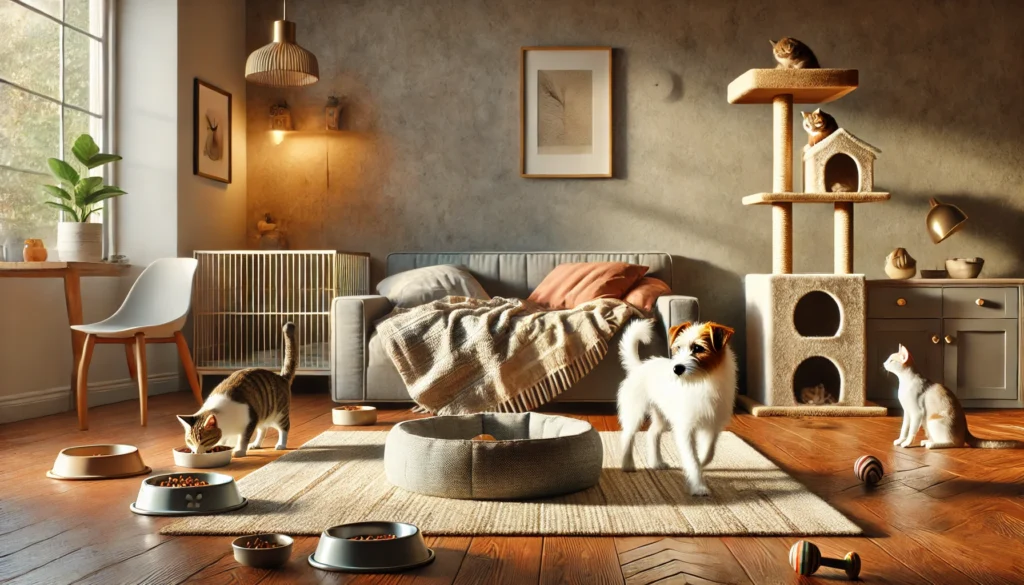Welcoming a new dog or cat into your home is an exciting and heartwarming moment. Whether it’s a playful puppy, a gentle senior dog, a curious kitten, or a rescued adult cat, preparing your space properly can make a huge difference in their adjustment and happiness. In this article, we’ll guide you step-by-step through preparing your home for a new furry family member with practical, everyday tips.
Create a Safe and Comfortable Space
One of the most important things when bringing a pet home is to ensure they have a designated safe space. This could be a corner in your living room, a cozy crate, or even a quiet spare room.
For Dogs:
- Choose an area away from heavy foot traffic.
- Place a soft bed or blanket where they can rest.
- Keep food and water bowls nearby but not too close to the sleeping area.
- Add toys for comfort and entertainment.
For Cats:
- Cats love vertical space. If possible, install a cat tree or shelves.
- Provide a covered space, like a cardboard box with a blanket, for hiding.
- Place a litter box in a quiet, low-traffic area.
Pet-Proof the House
Pets are curious by nature, and a new home is full of unexplored treasures (and hazards). Take time to pet-proof your house.
- Secure wires and cords to prevent chewing.
- Store cleaning supplies, medications, and small objects in closed cabinets.
- Avoid leaving food on low tables or kitchen counters.
- Ensure windows and balconies are secure to prevent falls.
Choose the Right Supplies
Before your pet arrives, stock up on essential items that will make their transition smoother:
- Food and water bowls: Stainless steel or ceramic are easier to clean.
- Quality pet food: Tailored to their age and size.
- Bedding: Washable and soft.
- Toys: Safe and suitable for chewing or chasing.
- Collar and ID tag: In case they wander off.
- Litter box (for cats): Plus, scoop and litter.
Optional items like scratching posts (for cats) or chew bones (for dogs) can also help avoid behavioral problems.
Introduce Gradually to Family and Spaces
Let your pet explore at their own pace. Don’t force interactions with family members, especially children.
- Start with one room and expand access slowly.
- Let them sniff and get used to scents.
- Use calm, encouraging tones when speaking.
If you already have other pets, introductions should be slow and controlled. Keep them separated initially, allowing them to smell each other from behind a door before face-to-face meetings.
Establish a Daily Routine
Pets thrive on routine. Start building one from day one:
- Set feeding times and stick to them.
- Take dogs out at regular intervals for bathroom breaks.
- For cats, clean the litter box daily to encourage use.
- Schedule playtime and cuddles consistently.
A consistent schedule helps reduce stress and builds trust with your new companion.
Keep Noise Levels Low
Loud noises can be overwhelming, especially in a new environment. Try to:
- Avoid loud TV or music at first.
- Speak softly when interacting with your pet.
- Allow them time to adjust before inviting guests over.
Monitor Behavior and Health
While you don’t need to be a vet, keeping an eye on your pet’s basic behavior and condition helps spot early signs of discomfort or stress:
- Are they eating and drinking?
- Are they using the bathroom properly?
- Are they hiding excessively or pacing?
If something feels off, it’s okay to seek help from a qualified professional. Just avoid trying to diagnose anything on your own.
Encourage Positive Reinforcement
Reward your dog or cat for good behavior with treats, petting, or verbal praise. This helps build trust and makes training easier.
- Avoid punishment or yelling.
- Use simple words consistently (like “No,” “Good,” or “Come”).
- Make rewards immediate so they associate them with the action.
Keep It Clean and Hygienic
Maintaining a clean space isn’t just for your pet’s health—it’s for yours too.
- Wash bedding weekly.
- Clean food and water bowls daily.
- Sweep up fur regularly.
- Use pet-safe cleaning products.
Be Patient and Present
Perhaps the most important step in preparing your home is preparing yourself. Dogs and cats need time to settle in, and each one will adjust differently.
- Some pets may hide or be nervous for days.
- Others may attach themselves immediately.
- Stay calm, reassuring, and patient.
Over time, your new dog or cat will feel that your home is their home too.
Building a Happy Life Together
Bringing a pet into your home is a long-term commitment, and the first few days set the tone for a healthy relationship. By preparing your home thoughtfully, you’re not just avoiding accidents—you’re laying the foundation for trust, joy, and love.
Take it step by step, and enjoy the journey!






